With savory tomato ketchup fried rice wrapped in a soft and thin omelette, Omurice or Omelette Rice is a Western-influenced Japanese dish that‘s popular among Japanese of all ages. This easy recipe is inspired by the Japanese drama Midnight Diner.

Fried rice flavored with the beloved American condiment ketchup and encased in a golden omelette pillow, Omurice (オムライス) or Omelette Rice may not be your typical choice when you visit your local Japanese restaurants. It’s easy to mistake the dish as a fairly recent fusion invention of modern Japanese cuisine.
However, this humble dish has been a popular yoshoku (western-style Japanese food) for over a century. That’s right! It is a Japanese rendition of ‘mash-up’ comfort food at its best. It’s got grain, vegetables, proteins, and a big bright sunny disposition, enough to make a fried rice fiend wake up hungry.
This delicious Omurice was featured on the popular Japanese TV drama called “Shinya Shokudo (深夜食堂)” or “Midnight Diner: Tokyo Stories” which is available on Netflix.
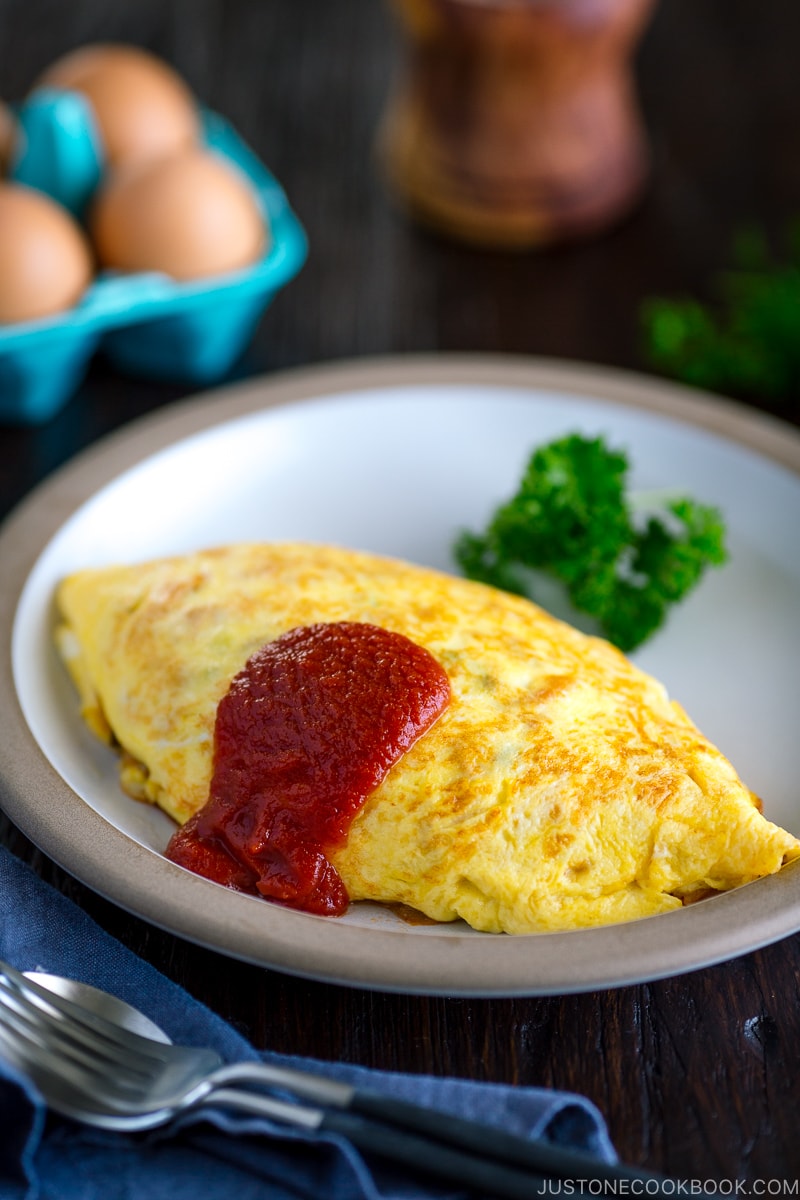
Omurice and Yoshoku
Omurice (オムライス) is a loanword from both Omelette (Omuretsu, オムレツ) and Rice (raisu, ライス). In this recipe, fried rice is seasoned with the sweet and sour flavor of ketchup and tomato puree, and tucked inside a thin blanket of a golden fluffy omelette. It’s sweet and savory, the whole ensemble of Omurice is just so comforting to many Japanese people that it is considered one of the most popular yoshoku (western-style Japanese food).
Yoshoku started to appear around the Meiji Era (1868–1912) after Japan ended its isolationist foreign policy and opened the ports to the West. Tonkatsu, Korokke, Hambagu, Curry Rice, Doria (rice gratin), Cabbage Roll, Spaghetti Napolitan, and Omurice are just some of the familiar dishes in the category. They have katakana names to emphasize their foreignness, using the word “raisu” (ライス, rice) instead of “gohan” (ご飯, rice) for example. Another easy way to tell these dishes apart? They are often served with fork, knife, and spoons, instead of chopsticks.
At the time, foreign ingredients were difficult to find in Japan so people made yoshoku using local ingredients. Even though the dishes may look like Western dishes, the taste is still distinctly Japanese. I think that has unintentionally made yoshoku dishes uniquely Japanese.
You may have noticed the abundant use of ketchup in Western-style Japanese dishes. Brought in by the American army who came to Japan after World War II, ketchup was used in dishes to replace tomato sauce which was not easily accessible then. Since it is convenient and tasty, ketchup continues to become the mainstay in the Japanese kitchen pantry.
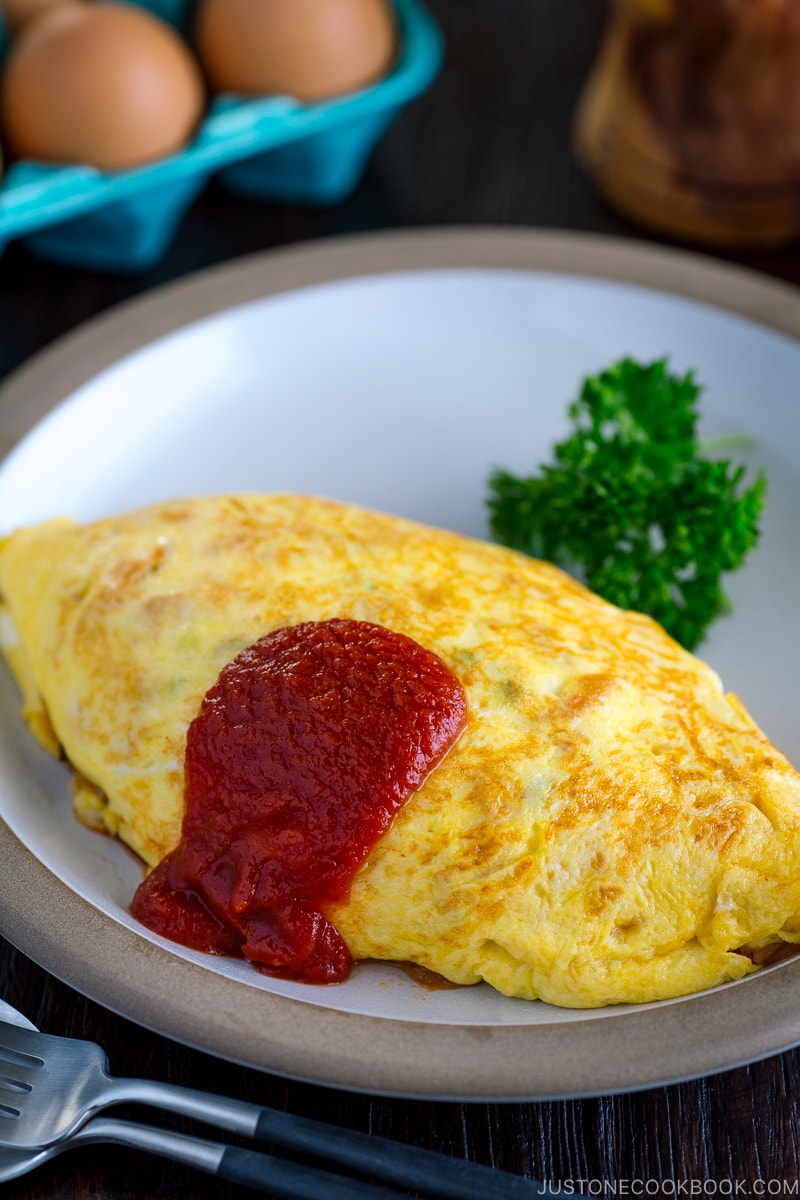
Who Invented Omurice?
There are 2 strong theories on Omurice’s origin.
Theory 1: When the owner at a yoshoku restaurant Hokkyokusei (北極星) in Osaka learned about a regular customer who wasn’t feeling well, he quickly cooked up simple fried rice with mushrooms and onion seasoned with ketchup, and carefully wrapped with omelette to serve the customer so he would regain his stamina. The customer loved it so much that he asked for the menu name. The sharp-witted owner came up with the name “Omurice”. This Omurice is much closer to what Omurice is now.
Theory 2: Simple fried rice with egg, onion, and minced meat was served as a meal for workers at Renga-tei (煉瓦亭) in Tokyo. Other customers were drawn by the vibrant egg fried rice that they started requesting it, and that’s how Omurice became an official restaurant menu.
Whichever story you prefer, I think it all started with Omurice’s ability to hit the right spot, especially when you crave comfort food.
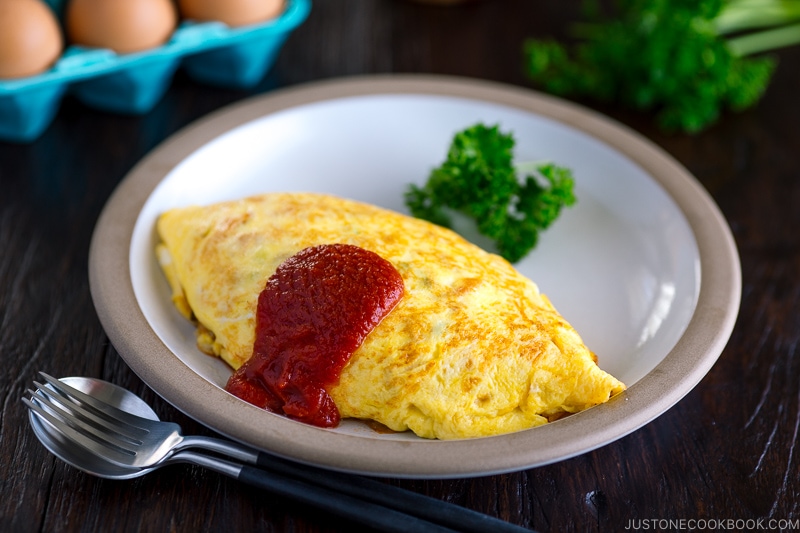
Omurice (Omelette Rice) – 2 Ways
In general, there are two ways to make Omurice. The original one called Ganso Omurice (元祖オムライス) is to wrap the fried rice with a thin omelette, like the one I shared today. Some people prefer light yellow omelette (no burn spot), but I personally prefer my Omurice to have a slightly golden color (which adds flavor) and the omelette is still creamy and soft on the inside.
The second style of Omurice is called Fuwatoro Omurice (ふわとろオムライス). First, you make ketchup fried rice and transfer it to the plate. Then you make the omelette, and while it’s fluffy (fuwa) and runny (toro), place it on top of the ketchup fried rice. Before serving, you slice the center of omelette and runny egg yolk to cover the fried rice. You might have seen this style of Omurice in the movie Tanpopo. Hence, it’s also called Tanpopo Omurice (タンポポオムライス).
Which one is your favorite style?
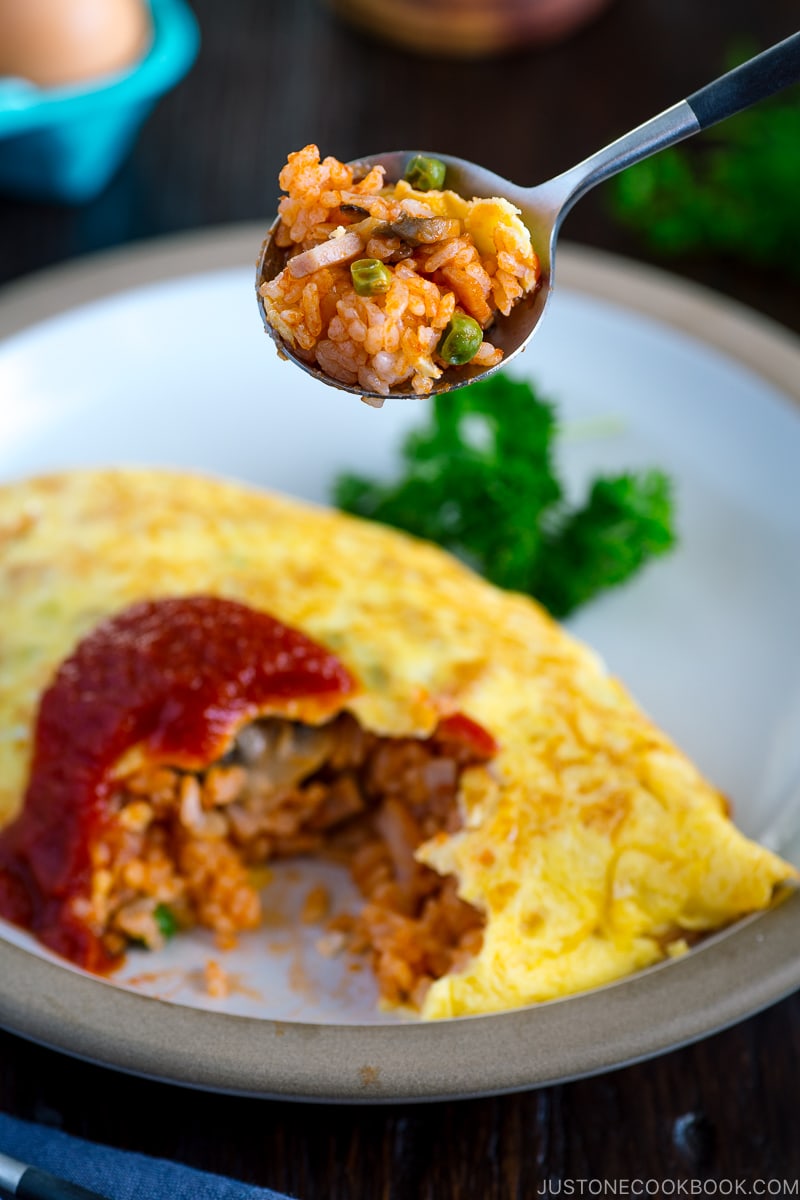
Variations of Omurice (Omelette Rice)
Here is the list of Omurice variations that I have seen or thought of. As you can see, the possibility is endless. Feel free to take the liberty to use whatever ingredients you have in the fridge and make your own version. Creativity is welcome when comes to making Omurice!
Fried Rice Ingredients
- Ham
- Chicken
- Seafood
- Onion
- Carrot
- Green peas
- Mushrooms
Fried Rice Flavor
- Ketchup
- Tomato sauce
- Butter
- Garlic
- Salt & Pepper
Sauce over Omurice
- Tomato Ketchup
- Tomato Sauce (sometimes with extra tomatoes, mushrooms, seafood or more ingredients)
- White Sauce / Bechamel Sauce (sometimes with seafood)
- Japanese Curry Sauce
- Hayashi Sauce
- Demi-glace sauce
- Ankake (starchy thick sauce)
Filling or Additions on top of Omurice
- Cheese
- Hambagu
- Fried Fish
- Korokke
- Herbs
The cooking method for Omurice is really quite simple. It’s a perfect quick one-dish meal for busy moms, college students, and singles as you can whip it up in a short time. Trust me, nothing beats good fried rice with a fluffy egg. I hope you enjoy making Omurice at home!

Wish to learn more about Japanese cooking? Sign up for our free newsletter to receive cooking tips & recipe updates! And stay in touch with me on Facebook, Pinterest, YouTube, and Instagram.

Omurice (Omelette Rice)
Video
Ingredients
- ¼ onion (2.1 oz, 60 g)
- 4 mushrooms (1.8 oz, 50 g)
- 4 slices ham (2.8 oz, 80 g; or 2 thick slices)
- 1 Tbsp neutral oil
- 3 Tbsp green peas (defrosted and drained, if frozen)
- ⅛ tsp Diamond Crystal kosher salt
- ⅛ tsp freshly ground black pepper
- 2 cups cooked Japanese short-grain rice (cooled or day old; frozen cooked rice works well)
- 2 Tbsp unsalted butter (divided)
For the Tomato Sauce
- 3 Tbsp ketchup
- 3 Tbsp tomato paste
- 2 Tbsp water
For the Omelette
- 4 large eggs (50 g each w/o shell) (divided)
- 2 Tbsp milk (divided)
Instructions
- Gather all the ingredients. For the cooked rice, please note that ¾ cup (150 g, 1 rice cooker cup) of uncooked Japanese short-grain rice yields 2¼ US cups (330 g) of cooked rice. See how to cook it with a rice cooker, pot over the stove, Instant Pot, or donabe. Make sure your cooked rice is at room temperature or slightly warmer. If you‘re using frozen cooked rice, defrost and warm it. Tip: If your cooked rice is still hot, transfer it to a large bowl or baking sheet (for more surface area). Spread it out and set aside for 60 minutes, uncovered, to remove the moisture.

To Make the Ketchup Fried Rice
- To make the tomato sauce, combine 3 Tbsp ketchup, 3 Tbsp tomato paste, and 2 Tbsp water in a small saucepan and mix all together. Set aside.

- Clean 4 mushrooms with damp towel and slice them.

- Slice ¼ onion and dice into small pieces.

- Cut 4 slices ham and dice into small pieces.

- In a 10-inch frying pan, heat 1 Tbsp neutral oil. Add the onion and sauté.

- Add 3 Tbsp green peas, the mushroom slices, and the ham slices.

- Season with ⅛ tsp Diamond Crystal kosher salt and ⅛ tsp freshly ground black pepper.

- Add 2 cups cooked Japanese short-grain rice (cooled). Break up the chunks of rice with a spatula.

- When the rice and ingredients are combined well, add 3–4 Tbsp of the tomato ketchup sauce and mix well. Make sure to save some sauce for the topping. Divide the fried rice in 2 portions.

To Make the Omurice (makes 2)
- Make one omurice at a time. First, crack 2 eggs in a small bowl and add 1 Tbsp milk and a pinch of salt. Whisk it all together.

- Heat another frying pan over medium-high heat and add 1 Tbsp butter. Swirl the pan to distribute the melted butter, then add the beaten egg.

- Quickly swirl the egg around the pan with chopsticks. When the mixture is set but still runny, add one portion of ketchup fried rice in the middle. If you feel the pan is getting too hot, remove the pan from the heat and put on top of a damp towel to cool the pan.

- Wrap the ketchup rice on both sides with the egg omelette. It doesn’t have to be perfectly wrapped, but make sure to create an “edge” around the fried rice with the omelette.

- Place the serving plate under the pan and invert the pan to transfer the omelette rice.

- Place a piece of paper towel on top and gently shape the omelette like an American football or rubgy ball. Repeat this process to make the other omurice.

To Serve
- Top the omurice with some tomato ketchup sauce that‘s either at room temperature or reheated. Garnish the omurice with parsley. Enjoy!

To Store
- You can keep the leftovers in an airtight container and store in the refrigerator for up to 3 days and in the freezer for a month.
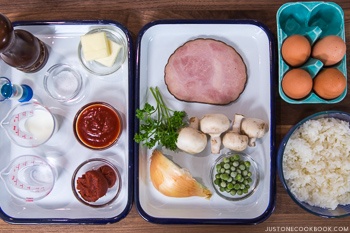

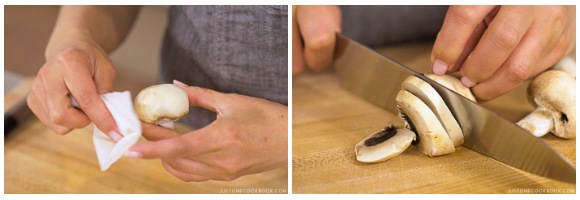
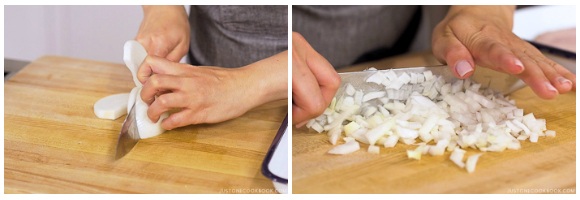
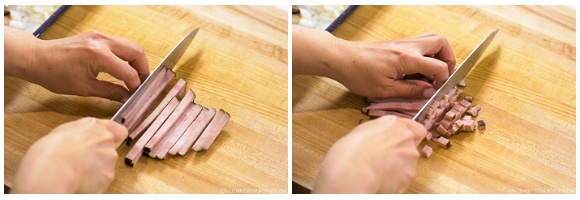
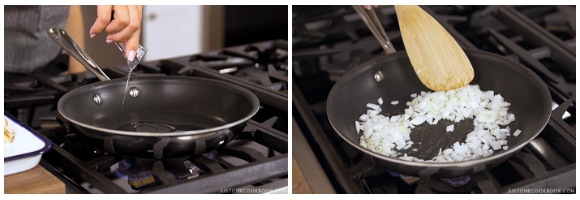

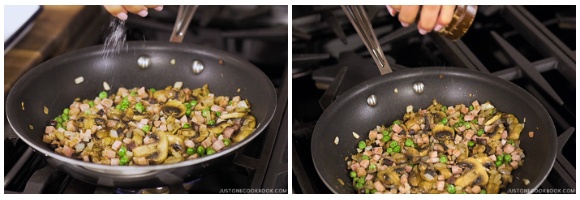
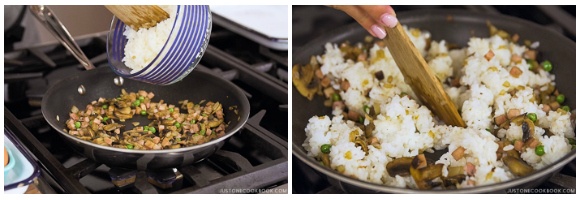

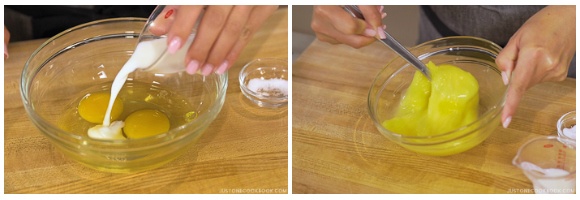
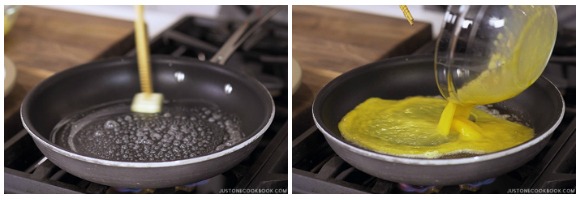
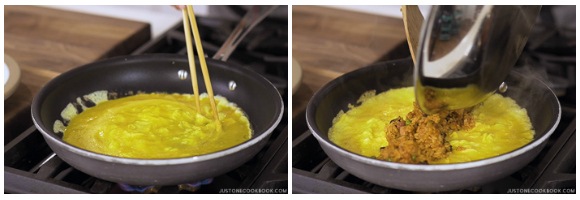
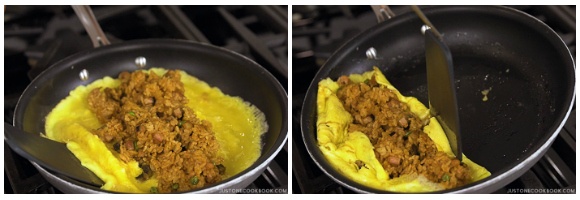
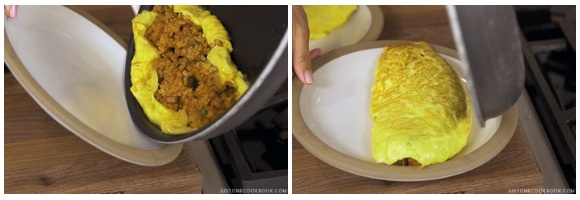
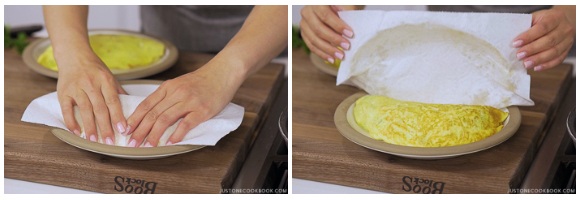











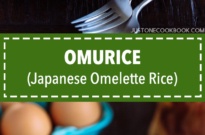

This recipe has become our *favorite* simple comfort food to make on a rainy day or when we are tired after work. I’ve gotten pretty good at flipping the omelet out in one piece! In the spoonfuls of warm sauce that go on top I like to mix in a little fish sauce so it’s not pure tomato. we’ve have used all kinds of leftover vegetables and protein, but my favorite is mushrooms ham and green peas as Nami wrote. I’m so grateful for this recipe!!!
Hi Rachael! Aww… Nami and JOC team are so happy to hear your favorite is Nami’s combination!👏🏻
Thank you very much for trying Nami’s recipe and sharing your cooking experience with us.
Happy Cooking!
Hi Nami! My mom used to make this quite often as a child. I think she used hamburger instead of ham—not sure though as it was a long time ago! I LOVE your site and use it more often than any other site these days. I make dinner for my mom now as she is 92 years old. The tables have turned and I am her Japanese cook as that is what she prefers to any other cuisine. Grateful for your site and all the homey dishes you have presented so clearly!:)
Hi Naoko! Aww.🥰 Thank you very much for sharing your story!
We couldn’t be happier to hear how much joy and excitement Nami’s recipe has brought to you!
We hope you continue to cook many Japanese dishes for your mom! 💝 Happy Cooking!
I love this site and many other recipes from JOC, but didn’t care for this one. The sauce was very bland, so I added onion powder and Worcestershire sauce. Also added soy to the fried rice. It was edible but don’t think I’d attempt it again. Perhaps this specific dish just isn’t for me.
Hi Ryan! Thank you very much for trying many recipes from JOC and for your feedback.
We are very sorry to hear this dish wasn’t for you. We currently have 800+ recipes on the website, and we hope you keep continue to explore other recipes.💝
Hi Namikosan, this reminds me of my years in Osaka. My family loves omurice! Every time we go to Uwagimaya in Seattle they beg for omurice for dinner. It’s definitely in our dinner rotation. I never used tomato paste in my rice, just ketchup. I believe there would a nuclear meltdown if I changed things now. Thanks for sharing my heart for Japanese food.
Hi Debra! Thank you very much for reading Nami’s post and sharing your story!
We are so glad to hear your family loves Omurice!
Hi! Can you make this with freshly cooked rice? I know some fried recipes require stale rice so that it doesn’t get mushy. What’s the best option for this recipe? Thank you! 🙂
Hi Hallie132, Thank you very much for trying Nami’s recipe!
If you like fried rice-type texture, the best option for this recipe is cold/cooled cooked rice. As you mention, freshly cooked rice is too moist and will be a bit mushy. It’s up to your preference.🙂
Ketchup is chinese not american, it is a chinese word for soy sauce,
like cha is chinese word for tea, indian word chai comes from this cha. Fried rice a rice cooked with ketchup is not western cuisine at all, it comes from China
Hi Andy! Thanks for sharing it with us!
Not quite. The Chinese version is a fish sauce, which the British imported and replicated using mushrooms.
Tomato ketchup was invented in the US in the 1830’s.
https://www.thespruceeats.com/ketchup-catsup-history-1807618
Why is the sauce made in a small saucepan? I read over the recipe several times and didn’t see anything in the instructions about the sauce needing to be heated at all; however, in the YouTube video it shows the sauce being heated on a gas stove. Is it for making the sauce a little more fluid? What heat setting should the sauce be warmed on?
Hi Grace,
Thank you for trying Nami’s recipe!
The sauce can be served warm or at room temperature. If you would like to serve a warm sauce, we recommend using low-medium heat.
We hope this helps!
I’ve attempted the recipe three times now; ironically, the third time turned out just as messy (if not messier!) than the first try. The flavor is fortunately unaffected (delicious and comforting, of course). My husband was skeptical at first of the idea of tomato sauce with fried rice, but after tasting it, he said it might even be his new favorite comfort food for lunch! Two thumbs up for us, Nami-san!
My own skepticism regarding heating the tomato sauce resolved itself in the end—I ran out of tomato paste for the third try so I tried regular ketchup since I’ve seen depictions of omurice with a thinner zig-zag pattern. I typically keep ketchup in the fridge after opening instead of room-temp in my pantry or out on my kitchen counter, so it was still a bit chill when I put it on the omelet… what a contrast! It’s definitely worth the extra effort to warm the sauce (or at least give it enough time to come to room temperature), as it complements the comforting fluffiness of the omelet so much better and also softens the otherwise distinct tang from the vinegar in the ketchup.
One thing that I found helps immensely with trying to fold the omelet without tearing the edges is a silicone spatula! I’ve been using an IKEA spatula, the flat, curved kind one would use for scraping the sides of a mixing bowl for baking. The tapered, curved edge of the spatula is perfect for slipping under the egg crepe without bunching the edges, and the non-stick silicone is almost like magic for lifting the sides and nudging into shape around the fried rice, although of course you still have to be gentle with the egg portion. If only my “non-stick” pans were as cooperative, haha! I’ve wound up with beautiful edges and then a big hole in the center of the omelet that stuck to the pan after flipping. But my frustration only fuels my determination to reach the ideal omurice; I have a lot of tasty practice ahead of me!
Hi Grace, We are glad to hear your husband has found a new favorite comfort food.😃
Yes! Ketchup works well for this recipe too. Using the spatula is a great idea! Thank you for sharing your cooking experience with us!
I was looking for the vegetarian recipe and found this recipe. I remember enjoyed this meal while we were in Tokyo. And curious at The Tokyo midnight diner from Netflix ( I read it from your story above the recipe). I made this for our diner, it was easy to made and really comfort food, I leave out the ham to make vegetarien style, and enjoy the Tokyo Midnight diner after diner. We enjoy it both! Thank you!
Hi Caroline,
Aww. Thank you for sharing your story and for your kind feedback.
We are so glad to hear you enjoyed this dish!
Hi Nami,
I am keen to try cooking this . Would you recommend cooking this with freshly cooked rice or rice that’s cooked earlier and left in the fridge like Chinese fried rice ?
Hi Linda! Honestly, either one works. Unlike fried rice, it’s all wrapped inside the egg crepe, so it does not really matter if the rice separates or not. Probably more personal preference?